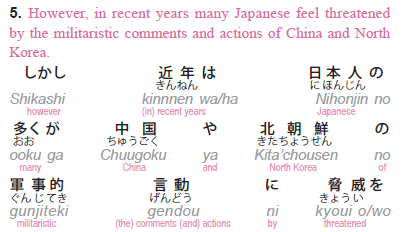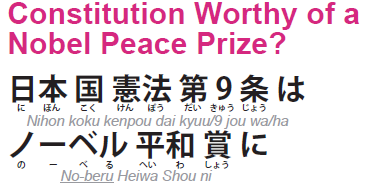
The monthly magazine that introduces the real Japan to the world, in English and Japanese

Hiragana
Times introduces the real Japan to non-Japanese by looking at Japan as
an attractive, unique town in the global village. Inside Hiragana
Times, the world of Japan becomes reality, and one can experience the
cultural frontier between Japan and the rest of the world.
Hiragana Times has been published since 1986 and has readers in more
than 100 countries. Readers are mainly in their 20s and 30s, but the
number of middle-aged and elderly readers has been rapidly increasing
in recent years.
Hiragana
Times is a truly unique magazine in which you can study language while
learning about Japan. Each Japanese paragraph is followed by its
English translation or vice versa, and furigana are placed below each
kanji to make Japanese study even easier. Digital version provides
audio.
The articles are also used in universities, a dictionary and more
Hiragana
Times articles are used every year in some Japanese university English
exams, and used as a Japanese text in overseas universities. All the
translated sentences from every issue are converted into Braille.
Furthermore, they have been also included in a well-known online
dictionary, and used as online translation improving data by global
enterprises and university lingual study institutes. At the NTT All
Japan Town Magazine Festival, Hiragana Times has twice been awarded the
Grand Prize.

The Uniqueness of Hiragana Times
Hiragana is the base of the Japanese language
Spoken
Japanese consists of 46 syllables and 86 syllables of their modified
forms. Hiragana characters represent these syllables. In other words,
hiragana is a phonetic script. At elementary school, students learn
hiragana first. Then they learn katakana and kanji. Fairy tales and
picture books for lower grade students of elementary school are written
in hiragana.
You can read anything by mastering only 46 hiragana characters
For
adults, almost no books or magazines in hiragana-only are available,
but Hiragana Times provides you with texts that can be read strictly in
hiragana. By knowing hiragana you will also be able to write anything
that you can speak.
Furigana (Hiragana) is placed on each kanji
It
is said that the Japanese language is one of the easiest languages in
the world, if you do not have to learn Kanji. However, the knowledge of
kanji is necessary to improve your Japanese proficiency. For all kanji,
furigana (hiragana) is placed in the magazine, allowing one to learn
kanji at the same time as reading in hiragana.
You can read them without a dictionary
As
the English sentence blocks and Japanese sentence blocks are
alternately displayed, you can easily compare the English sentence with
the Japanese sentence and grasp the meaning without a dictionary.
Furthermore, the articles are selected from contemporary Japanese news
and topics, so you can obtain the knowledge of Japan and study the
language at the same time.
Best for the Japanese Language Proficiency Test (JLPT) preparation
JLPT
places an importance on comprehension (the ability to read and
understand). It applies to hearing tests, too. Since it is hard to
predict the JLPT questions, it is difficult to know how to prepare for
the test. Hiragana Times, which includes many expressions and kanji
that often appear in the tests, especially 2nd and 1st grades, would be
is one of the best sources to improve your comprehension, for the test.
Revolutionary multi-level texts
There are more features in the 13-page “multi-level texts” section.
Why does the Multi-level Text attract Japanese learners?
The texts include all the necessary factors for effective Japanese language study.
________________________________________
An example of multi-level text
The texts provide reading enjoyment as an insight into Japan
- Multi-level
texts are written in easier expressions for adults. They give an
insight into Japan that non-Japanese should be aware of, and are highly
reputed for not only being educational, but also entertaining and
informative, so that readers will be encouraged to learn Japanese
- Japanese sentence is followed right after English sentence
- You
can read English texts with Japanese texts, comparing their sentence
constructions. Appropriate English words and phrases are positioned on
each Japanese word or phrase under the Japanese texts, in addition to
furigana below each kanji. So, you can instantly grasp the meaning.
- English
sentences and English furigana (words and phrases) are printed in red.
So, if you look at the text through a red acryl sheet, they disappear,
and you can see only Japanese text. (print only)
- In the digital version you can switch to Japanese-only by clicking an icon
- Furigana (hiragana) is also placed with each katakana
- Katakana,
another phonetic script, is used mostly for loan words. Since hiragana
is placed not only on kanji, but also on katakana in multi-level texts,
you will be familiar with and learn them, while reading the hiragana
texts.
- You can also read in romaji

As
multi-level texts are also being written in romaji, those who have no
knowledge about Japanese characters can read, as long as you know the
English alphabet. Romaji was created to replace hiragana (katakana)
characters with the alphabet. So, you can easily learn them while
reading the text in hiragana.
You can practice Japanese text inputting
Most
Japanese people type in romaji to a PC to get Japanese texts. In
multi-level texts Glomaji (Global romaji) style, which was developed by
Hiragana Times, is used. Using Glomaji you can get the correct Japanese
text. If you try to input the Glomaji text into a PC, you will be able
to get the Japanese text printed in the magazine. It will be good
practice for inputting.
With
these you will be able to understand the meaning of the text on the
spot without having to use a dictionary, regardless your level of
Japanese.
* The audio of the “Multi-Level Texts” is included in the digital version subscription
Digital version with audio
The
digital version of Hiragana Times contains exactly the same contents
and layout as the printed magazine and can be viewed page by page on
the Web and enlarged or reduced simply by clicking on the screen. By
printing every page on your printer, you will be able to create your
own Hiragana Times magazine.
The audio is accompanied by the “Multi-level texts” (13 pages)
• Audio is recorded in easy listening English and Japanese by professional narrators.
• English and Japanese sentences are recorded alternately, sentence by sentence.
• While reading the texts, you can hear the audio using a PC, iPad, Phone and android devices.
Many fascinating articles for readers
2014 Contents
Topics & Event
Events, useful information and new products that non-Japanese would be interested in.
Japan Products
Introducing unique Japanese products.
Spotlight
Figures or spots which are currently talked about are introduced.
Social News
Heart-warming topics that mass media would rarely report.
Trends
Booming new business or newly emerged social phenomenon.
Special Interview
Asking about their impressions of Japan and such to the ambassadors to Japan (or their wives), or other influential people.
Travelling Japan
Introducing newly emerged tourism business
Cool Japan
Report of Cool Japanese products or services.
———————Multi-level texts ——————————————————————
(Special pages designed for Japanese study)
Close Up Japan
Current Japanese topics and the issues related to non-Japanese are explained.
Japanese TPO
Expressions that are used in daily life, but rarely appearing in ordinary Japanese texts.
New Expressions & Buzzwords
New words and buzzwords which are currently in use.
Japan Watching
Japanese way of living is described through a humorous episode.
Behind the Scenes
Behind-the-scenes looks at interesting Japanese themes or incidents.
——————————————————————————————————————————————
Proper Noun Trivia
The meanings of names of places, people, companies, brands and so on.
Japanese Cultural Understanding Test
Questions of Japanese common knowledge, for non-Japanese.
Nihongo Puzzle
Searching vocabulary and kanji of JLPT N5 level.
My Japan & My Country
Reader’s view about Japan and a comparison with their own country.
Hot Spot
Sightseeing spots not well known to foreigners, but popular among Japanese.
Popular menu
Popular best three menu choices, from a leading restaurant chain.
Japan Profiles
Introducing a unique person or business.
Brand Story
A report; how a famous brand was created.
Japanese in Japan
A foreign student or worker interview;what their Japanese life is like.
Japanese Comics
A outline of well-known manga books is illustrated.
How to purchase the Hiragana Times
• On sale on the 20th of every month in Japan
•
Available in Japan at mid-sized and large bookstores. We recommend the
foreign book section of a larger book store.
• Available outside Japan at Japanese bookstores or Japanese centers in major cities of the world.
• The price in Japan is 500 yen. Outside Japan the price varies.
• To obtain a subscription, please fill in the subscription page on the site.
• Available also at Apple’s Newsstand and Google Play.
• For school use as a class text, supplemental material, library, or group use, order from below.

